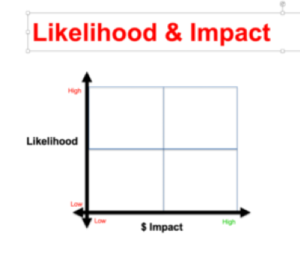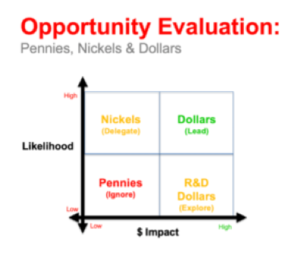How Do You Know You Have the Right Core Values?
Years ago, when I heard about companies using core values as a tool to communicate behaviour important to them, I thought it was a load of fluff and had no real business value.
Wow, was I wrong!
The issue was that I was exposed to companies with mediocre, two-paragraph mission statements and beautifully articulated core values that were only words on paper. They didn’t seem to be alive in the culture at all.
Many years later, I realized that, although those companies had great intentions, they didn’t know how to really build a culture and core values with teeth. The ones that do, know how to deliver what their customers want, have a strong culture, and use their core values as guard rails to keep the company sustainable.
If you have any doubt about the importance of core values, just think of a situation you’ve been in where people had dramatically different beliefs about how people should be treated, or how the work should get done. In those situations, a huge portion of your energy goes to try to find a way to work together - or around each other - that distracts you from doing the quality work you wanted to do, in the first place.
The right core values create common guidelines that reduce friction in the system and make it easier for us to deliver what we are accountable for. When you boil it down, their ultimate role is to define the behaviours required to be an effective employee; and guidelines for managers to hire people, train, promote, reprimand and, unfortunately, fire those who don’t fit.
In simple terms, they allow you to break someone’s behaviour into distinct components:
- What - Their ability to meet expectations and goals in their role
- How – Their ability to be in alignment with each other.
“Core Values becomes one of the most important decision-making tools we have. When it comes to people, there are lots of different ways to get results, but we want people who will do it a similar way and with a similar belief system. And when people don't, it is a nightmare - hard on them and hard on the team because they have a different belief in how the job should be done, or how we should treat people.”
Represent Your Unique View
Most companies’ core values aren’t really representative of their unique view of operating in the world because their process to define them was flawed. They come up with a list of the nice attributes of a human being, but they are not requirements to be here. And if you don’t play, you can’t stay.
One company I worked with had a core value of “Accountability”. After working with them for a couple of quarters, they consistently only achieved half their goals and were generally OK with that. We then had an interesting conversation about how “Accountability” was an aspirational value and not a core value, otherwise people would be up in arms.
“Compassionate and understanding” was closer.
Another company had a core value called “Team Player” which meant, in their busy season, no one could leave until all the work was done. One person on the admin team – maybe the smartest in the whole company – would get all her work done by 2pm, and to her credit, would stay another two hours to help the rest of the team. But she’d go home at 4pm, leaving the everyone else there until 8pm. When asked about it in a feedback session, she said it wasn’t her fault that the others were slow, so when it became clear that her actions weren’t aligned with that non-negotiable core value, she could no longer stay.
This was also an acid test for the CEO about the core value “We’re all in it together”.
How Do You Know if Your Core Values are Right?
If your core values are truly accurate, you should be able to say ‘yes’ to most of these points:
- You empower other people to make hiring/firing decisions using core values as the only measure of their character. This works because the top people fit the core values very well and the high-performing jerks would have violated at least two.
- You have a list of four or five not 15. Fifteen is a LIST of values - only four or five are CORE non-negotiable values.
- You are willing (and have taken a financial hit) to protect your core values. If anyone has violated them, you willingly pay to resolve it.
- They are a reality now, not aspirational statements of who you would love to be one day. This means the majority of your leaders live them consistently.
- If you do 360 feedback and use core values as one of your measures (which we recommend) your A-Players, those who are high-performing and fit the culture well, score at least 85% to 90% on each one.
On a side note: For one of our companies, we knew the core values weren’t right when we saw the results of the CEOs 360. This founding CEO scored between 70% and 90% on the core values when it’s normally 90% plus for someone like that when the core values are right.
- The language of the values is used throughout your company on a regular basis.
- If you were to make a list of the most toxic but high-performing people you’ve worked with - employees, customers, suppliers (in Your Oxygen Mask First call them Toxic A- Players) - they would violate at least a couple of your core values.
At the root, core values define how you and your team are freakishly unique – your belief systems that capture the nuances and amazing quirks of how you like to conduct yourselves.
The Challenge
- Are your core values truly required behaviours for your company?
- If you have them right …congratulations! How do you bring them to life more and what decisions might you need to make around those that aren’t in alignment?
- If you were to self-rate, on a scale of zero to 10, how much do you live these values?
If your values aren’t right, let us know and we can help you get to your core.
For more discussion about core values, listen to this episode of The Growth Whisperers podcast.
Get Crystal Clear About Who is In Charge
Accountability is a hot topic in a lot of companies - and with many leaders.
Sometimes it’s an issue because people aren’t accountable, and things get missed.
Sometimes, people want to be accountable when others think they shouldn’t, and it becomes a ‘stay off of my turf’ dynamic.
Whatever the reason, getting crystal clear on who is accountable saves a lot of grief.
Even for simple things in your personal life, like booking a family vacation. You want to make sure you know who’s booking the flights, the hotel, the rental car and tickets to the show.
That’s usually easy to figure out, with a small group of people but, in business, when it comes to larger and cross-functional teams, there’s a tool that’s been around for a long time – a best practice that helps you to get clear on project ownership that also makes execution and evaluation, at the end. much easier.
We also use it to debate decisions; and for rocks or goals in strategic planning.
“Someone needs to own it. There's a reason there’s only one steering wheel in a car.”
The RACI model helps you determine who is:
- Responsible: The person who does the work
- Accountable: The decision maker and the person who makes sure the work is done to the expected level. .
- Consulted: People whose opinions/input are sought before the decision is made or action taken. If you don’t consult the right people you may build a system that’s good in theory, but not in practice.
- Informed: People who are kept up to date on progress/completion of the task.
This may seem like overkill for some small organizations but, as companies grow and departments get bigger and work more independently, being clear - and defining and agreeing up front who is doing what - saves time, money and confusion.
For example, you don’t want customer-facing people finding out you’ve made changes to the invoicing system after a customer tells them.
And is IT accountable for the new CRM system or are the users?
And take new product development: people - sales, finance and everyone else - love to have input into marketing. There can be friction, or people wanting to take control too much – or not enough.
Being clear helps everyone.
The Challenge
- What projects do you have right now that would benefit from RACI?
For more about RACI, listen to this episode of The Growth Whisperers podcast.
Finding a Great Executive Coach
How do you find a great executive coach - the right coach - for you and your company?
Over many, many years, I’ve met some of the most interesting styles and flavours of coaches. Through the coaching community and, coupled with my own international experience over 25 years, here’s what I’ve learned. It starts with being clear about your needs, so let’s first talk about the difference between a coach, a consultant and a mentor. Each one has their place but they're quite different.
- A consultant is an expert in a specific area who works on a time-based project and will give you data and/or answers and recommendations.
- A mentor is someone who's been there, done that and can advise you.
- A coach uses a framework to ask the right questions - rather than giving you answers - facilitate conversations, and guide people to come to the right solutions for them.
An executive coach is a thought partner you build a relationship with to help you to get clearer and become more effective as a leader.
He or she challenges you and brings you to better insights - and ideally better execution of those insights.
In my world, we coach CEOs or senior executives one-on-one, and facilitate strategic planning sessions for companies.
The journey of leadership isn’t about the money, the corner office or telling everyone what to do. It’s helping all of those around you to reinvent themselves and become better leaders. Even if you're a manager and not the CEO, you still don't necessarily want to be told what to do. You want to be helped to make the right decision.
And that’s what a great coach does.
A lot of people in my field don't keep their clients for a long time because they have too much opinion and answer dispensing. And that's not what a lot of really successful people are happy to hear. They want perspective.
I’ve had an amazing mentor since my early 20s. Joff Grohne is an awesome guy who built a large design company called Karo Design and, I tell you, that guy would never give me an opinion. He’d always would ask me a question or bring out a framework. He was a mentor, who actually was an outstanding coach.
Are you coachable?
As a leader, are you open to new or different perspectives - to changing how you think and how you operate as a leader?
Are you willing to do learn and to do difficult things?
Sometimes it’s about you and sometimes it’s about the skill of the coach knowing how to get the best out of you - and that’s why coaches need to spend so much time on their own learning and growth. It’s about knowing h26 to get the best out of different people in different circumstances.
When a CEOs calls, I test to see if they are coachable because if they are not, they’re going to waste their money, and neither of us is going to feel good about it.
I once worked with a client who, it turned out, wasn't coachable enough, and wasn’t willing to deal with some of the nitty gritty of his business. And that's his prerogative. But nothing was changing, and he wasn’t getting value from me, so we talked about it and agreed someone or something else would be a better fit.
Qualities of a Great Executive Coach
When I’m looking at coaches to bring onto our team or to recommend to others, I look for people with experience and specific, proper coaching training. They must also be committed - obsessed - with really truly helping and having an impact, and be professional students, always studying and improving their skills.
A great coach has understanding and great pattern recognition through many experiences. For example, a client may do a strategic planning session once a quarter but a coach who has done it many, many times with many, many clients brings that experience with them.
Those who are really successful have put in Malcolm Gladwell’s 10,000 hours – I think I’m closer to 30,000! – know how to ask the right discovery questions to figure out what’s really going on, and to get to the root of the problem or the core of an opportunity. We don’t ask leading questions. Our job is not is not to prove that you're right, our job is to make you better.
The Right Fit
Like any personal relationship, you want to pick the right partner - a good fit for both the leader and the coach.
As a executive coach considering a client, I ask myself:
- Do I like this person? Do our values fit?
- Do I believe in them? Does he/she have the capability and desire to be a Level 5 leader?
- Can I stand behind and be proud to work with them?
- Would I be proud to introduce them to my other clients to be part of a community of CEOs?
- What do they want from their business?
- Can I become a great investment for them versus just an expense?
- Will this opportunity challenge and help me learn and grow?
We look for leaders who want to build an enduring business and a great relationship. If their vision is something else, then another coach could be a better fit.
A client should ask:
- Why are they a coach? What are they passionate about?
- How much time do they invest in learning and growth? Do they have a coach?
- Do they have the experience to multiply my capability and effectiveness?
- Are they a 14X coach that has been there and done that 14 times before? (Chapter 11, Quadruple Your IQ, Your Oxygen Mask First).
- They don't have to be an expert in your specific industry, but have worked with lots of people like you, at the stage that you're at, and have huge pattern recognition.
- Have they had formal coach training?
- How many long-term clients do they have?
- Are they prepared to challenge and risk upsetting me, with my best interests at heart?
Try Before you Buy
Any coach worth their salt will offer a few conversations up front to see how you’ll work together. This is especially important for one-on-one coaching.
We understand that leadership and growth is not an easy journey. It’s tough and painful - and can be much smoother in partnership with the right coach.
The Challenge
- If you’re not currently working with a coach, mentor or someone who helps you to continue to learn and grow, what would you benefit the most from doing so and how can you find them?
- If you are, congratulations! Now, what can you do to make your time with that person even more valuable?
Click here to listen more on finding a coach on my recent podcast The Growth Whisperers.
Task Management: Prevent Mice from Becoming Elephants
It’s fascinating how we can work on big opportunities, big challenges, important decisions and manage high pressure well - and then the tiniest thing can really stress us out. Like in a cartoon I watched as a child where a massive elephant was afraid of a tiny mouse.
Sometimes we get a backlog of little mice – 20, 40 or 100 of them scampering around our feet. Although there is no real danger and they are minuscule on the scale of what we deal with, they distract us, weigh us down and make us crabby.
They own you. They show up in your sleep and haunt your days until those mice become as big as elephants.
In my book, I call these Toads: all the annoying little things that you procrastinate dealing with which, once done, free your time and energy for bigger and better things (Chapter 5 Your Oxygen Mask First).
The little things you procrastinate consume far, far more energy than you believe – and that they deserve.
I’ve seen many successful leaders – distracted by loose ends tangling in their brains - taken down or reduced to lesser versions of themselves.
As silly as it may sound, sometimes we need an extra nudge and a reminder to get these things out of the way - like the CEO I currently work with who has been putting off renewing his driver’s license and getting a colonoscopy.
Name Your Toads
As part of our Quarterly planning and goal setting process, we ask people set their top goals for Work, Self and Life and to make a list of their toads in each area because, no matter how hard you push forward, they are like elastic bands, tied to your ankle and holding you back.
The 5 D's of Task Management
Here are five standard ways to lick a toad. Choose the one that makes the most sense for the situation:
- Do it. Bite the bullet immediately.
- Don’t do it. Say ‘no’ to the person who requested it, if it’s simply not yours to do.
- Delegate it. Assign an appropriate person.
- Delete it. Let go of it entirely. Decide it’s not going to happen.
- Date it. Commit to completing it by a specific date sometime down the road. Do not use this as a default. Only apply this when now truly is not the right time to deal with the task.
The funniest thing? You’ll find that, after thinking about your toads for days, months or years, dealing with them is never as bad - or as time-consuming - as you thought.
The Challenge
- What are the toads you need to lick this month – the top two in each area of your Work, Self and Life that you think about the most?
- Which of task management D's are you going to apply to those toads?
Say Less, Say Last or Say Nothing
In strategy, investments, leadership and relationships what you don’t do can be just as important as what you do.
With investments, professionals spend their days researching to generate a lot of ideas but only put their capital in a few places.
In business, to continue growing a company, there’s a natural process of editing out a high proportion of ideas people have and selecting the few that matter most. Otherwise, it’s very easy to dilute the focus of the company.
The same is true in leadership. In order to continue to grow, effective leaders realize that they must become better at not saying and doing things. When you work close to the front lines you can offer more direction and spend time teaching and demonstrating good work. However, as you get closer to the executive level you need to do less teaching and master the art of asking challenging questions. Contrary to what you might see in TV and movies, the most effective CEOs and leaders don’t actually share a lot of opinions – or provide a lot of answers.
Their job is to support their teams and make themselves useless (See Chapter 10, Your Oxygen Mask First).
Highly effective leaders stop the natural desire to answer people’s questions or provide guidance and try to say very little. If they do speak, they speak last, to not influence the thinking of the group. These leaders want people to think for themselves, to come with recommended solutions. They ask their teams deep, challenging questions to truly understand the issues. And they ensure that accountability sits on the shoulders of the best people on their team. (See Chapter 12, Your Oxygen Mask First, Stop Being Chief Problem Solver).
At their core, these leaders are like many parents. They understand that their role is to raise strong, independent adults who don’t need much from them, yet produce outstanding results.
Our job is to do our best not to stand in the way of their growth. Our role is to say less, say last or say nothing.
The Challenge
- Where do you need to be less helpful so that your people can grow and take more responsibility?
- Where can you say less, say last or say nothing?
What to Do with Your Cash Surplus
Growing companies face all sorts of problems and challenges. One of the biggest challenges (and my favourite) is what to do with cash surplus.
There is no right answer as every company has its own philosophy and strategy about how they want to manage cash. The first thing is to get clear on your capital strategy, which also extends into your borrowing strategy and how much leverage or debt you want to have on the balance sheet. The key is to have clear parameters on which everyone agrees.
We often think that growing companies consume a lot of cash. This can be the case for those aggressively wanting to expand their customer base and build market share. However, many others do build up a massive cash surplus. While not possible in every business model, with many of our clients in growth mode we optimize and use all the levers and strategies we’ve learned to build cash - and that position can change quite dramatically.
Then the problem goes from not enough cash to excess working capital burning a hole in their pockets - and people suggesting all kinds of wacky and amazing ideas of what to do with it.
Here are four basic strategies you can use for your war chest now (or when you build one):
- Hold it - to be prepared for a rainy day or a big opportunity
- Use it - as dividends for shareholders, paying down debt or buying back shares
- Reinvest it - what the remainder of this article is about
- Invest it - acquisitions or investments in future partners or start-ups.
The first important thing to assess is ow much of your cash surplus to save for a rainy day versus how much to use in other ways. In an abundant state, options 3 and 4 offer the most interesting opportunities because of the unlimited possibilities. Then the question becomes how to decide which working capital strategy brings the best return.
The ultimate measure of a CEO is an ability to create a return on the capital invested in the business (ROCI or similar measure), which is a reflection of how well they make the decisions about where to put cash and how to make the business better, as a result.
Evaluating cash Surplus Ideas
Many companies have a process for business cases, to rationalize, justify and back up with data whether or not to invest. Here’s the best approach I’ve observed:
Choose the best investment
Ideally have multiple ideas compete for the available capital, so that you aren’t in a “should we/shouldn’t we?” position. It’s more about which, of five or six or seven opportunities, is the best for our business model and to evaluate them by asking:
- How well does the idea fit with our strategy and can make the organization stronger?
- How large is the expected return?
- When and how likely are we to succeed?
- Who, on the team, has the capability and bandwidth to ensure our success?
Think of this competitive exercise like pitching a business idea on an episode of Shark Tank or Dragons Den.
In my new book The 4 Forces of Growth, we share a model called Stepping Over Nickels to Pick Up Dollars and you have to be careful not to do the inverse. This Pennies, Nickels & Dollars Model helps you to evaluate an idea by looking at the likelihood of success, and the size of the dollar impact:


Test your hypotheses
After debate and analysis, convert the idea to what Jim Collins calls a ‘bullet’. This small and repeatable low-risk test helps you prove the idea out without damaging the company. Identifying an opportunity doesn’t mean it will work, unless you’ve done something similar, that fits the fact pattern, many times before. This is a way to test and calibrate if your brilliant thinking pays out in real life.
Aggressively invest in the proven ones
When you’ve tested enough to prove your idea works then it’s time to implement the Jim Collins’ ‘cannonball’ strategy. This involves moving aggressively ahead knowing with close certainty that you’ll get the return on your investment.
Continue to evaluate and adjust
The part that many companies miss, or don’t have a process for, is ongoing evaluation. Just because you have shot the "cannonball" doesn’t mean that those investments should continue in perpetuity. Things change - and that can result in your returns not being fully realized.
This review, ideally done quarterly, looks up to five years back and evaluates the returns on every investment. The review also measures performance related to your initial investment, helping assess future opportunities.
The Challenge
- What is your capital strategy both in terms of additional cash generated and use of debt in the company?
- What is your process and evaluation for investment or re-investment?





